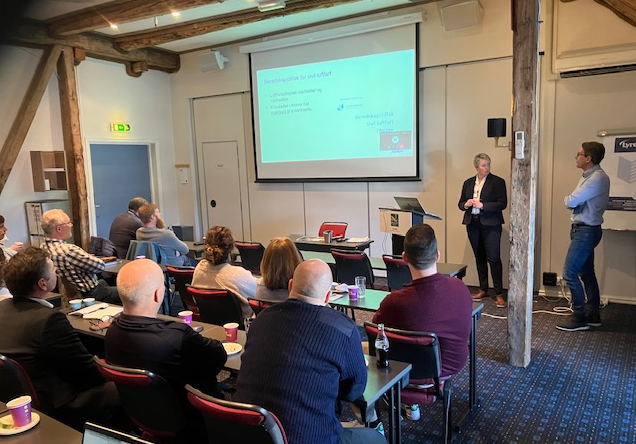Text: Alf Inge Molde
“In our experience, there is a big difference between organisations with an emergency preparedness in place, and those who are less prepared. It is difficult to start with a clean slate during a crisis,” says Heidi Wittrup Djup.
She knows what she’s talking about. In addition to being a psychology specialist, she is general manager of the Clinic for Crisis Psychology, formerly Centre for Crisis Psychology, in Bergen.
This group of experts has more than 30 years of experience from clinical handling and research on crises, grief and trauma. It has been engaged in emergency response and psycho-social follow-up in a number of very serious incidents over the last decades. These include the plane crash into the mountain of Torghatten in 1988, and the helicopter accident near the island of Turøy in 2016.
More information: Clinic for Crisis Psychology
In addition to partnerships with a wide range of public and private actors all over Norway, Clinic for Crisis Psychology has for many years formed an important part of OFFB’s emergency preparedness.
Helping the emergency team first
Three persons are on call at all time, all year round. If the first person on the list is unavailable, the phone call is automatically transferred to the next person on duty. All calls are answered.
“The first thing we do when the emergency phone rings, is to gather an overview of what has happened and who is affected. The situation is sometimes relatively clear. At other times, it is more chaotic and confusing,“ says Wittrup Djup.
During the first phase, the most important task is to assist the emergency management team, and to support the organisation of psycho-social follow-up activities.
Subsequently, the team agrees on the way forward, whether this implies travelling to an offshore platform to meet those directly affected, going to hospitals to meet the injured and their next of kin, or to assist in the follow-up of evacuees and their relatives at the Operator's Centre for Evacuees and Next of Kin.
More information: Operator's Centre for Evacuees and Next of Kin
The psychology specialists do not necessarily involve themselves in all relations, she emphasises. Their task is to strengthen the emergency preparedness teams and the operator’s personnel; to give advice and provide guidance, to keep sight of who is in need of extra care, and to keep track of what information is passed on and how. Some may also need to be told to take a break, in order not to exhaust themselves.
There are many factors to keep in mind. Which is why training and exercising is essential.
Care, safety, calm
“For people who have been involved in serious incidents and accidents, the most important thing is to be met with compassion, protection and calmness. We must prove to them that they are being looked after, that the worst is over, and that they are safe.”
“Many of those who have experienced serious incidents say, in retrospect, that they feel safer now than before. They have seen how the organisation stands up for and takes care of them. This is a good thing to carry with you into the future,“ says Wittrup Djup.
Some may need to see a psychologist, but everyone needs care.
Heidi Wittrup Djup
To others, the incident may mark the beginning of a life that is not going to be the same as before. They may enter a time of uncertainty, fear and anxiety. They need a professional, fellow human being who can bear their pain — someone who is calm, safe and trustworthy.
The most common “mistakes”
“Which are the most common mistakes one can make, when given a role in the follow-up of persons and their next of kin, who have been exposed to serious situations?”
“The fear of making mistakes may be the biggest challenge. You may be afraid of invading the other person. Instead, you are standing around waiting, stumbling over your words. But words may not be necessary. A glance, a hand on a shoulder or a cup of coffee in silence might be enough for this person not to feel alone. We must dare to show emotional courage.”
“Some may need to see a psychologist, but everyone needs care. I don’t think it is wise to professionalise being a fellow human being. Not everything has to be technically and professionally founded.”
More information: Call-centre
Some also raise the bar for what they would like to achieve, very high. They want to help, fix and arrange, but things may not turn out quite as they thought it would. Things are going to hurt, and grief takes time. Maybe they should aim to try to alleviate and make things easier for the person in question?
Be careful not to offer up clichés, she warns. They may be well-intended, but it is extremely hurtful to hear comments like “there’s a meaning to everything” and “you are lucky to have other children”.
Managers may become too focused on facts in their communication, and forget to recognise the purely human experience of those affected. Some also end up spending too much time explaining and defending what’s happened.
This is not the time for that.
Avoid focusing on emotions
“During the first phase, however, one should not pay too much attention to emotions. Stay clear of what people were thinking and feeling. Instead, stick to the facts about what’s happened, and the way forward. It is also essential to shield those least exposed from those most exposed,” she says.
It may be demanding to meet the affected in difficult circumstances. But some manage very well when the situation demands it. Real events are often characterised by calmness, and skilful people who shoulder responsibility, she explains.
“Some of the finest experiences I’ve had during crises, involve managers who are able to stand firm in the midst of a lot of pain—people who are wise and accessible, who are capable of keeping their focus on the way forward, and who take their share of the responsibility. It is touching, powerful and impressing to observe,“ says Wittrup Djup.
More information: Our members
Long-term planning is necessary
Experience from major incidents, both in Norway and abroad, indicates that the immediate emergency response is usually successful. Resources are in place, and a lot of people are willing to help. But if plans for the time following the immediate crisis are lacking, there are many who may find that help is no longer available.
When the affected are scattered among numerous employers and municipalities, we risk that the follow-up measures are distributed randomly. Who‘s responsible for these measures? The organisation? The municipality? This responsibility should be made explicit to everyone involved.
When people return to work, their workplace is also affected by the incident. One has to make room for reactions to surface at a later stage, and make sure help is extended. Some may decline the immediate offer for help, but may change their mind when reality kicks in, she says.
However, a degree of everyday normality must also be resumed in the workplace.
Coronavirus – restrictions and possibilities
“We’re still in the midst of a pandemic, where we are required to keep a distance, to limit close contact and observe infection control measures. Is it possible to offer good psycho-social follow-up during COVID-19?”
“It’s a challenge. We’re deeply affected by crises, and we need to be around other people and make physical contact. But we still have to be mindful of infection control, and take measures such as finding bigger locations, and more separate rooms, to accommodate several cohorts. It may not be optimal, but organisations should take responsibility and plan in advance.”
It is possible to create a feeling of closeness, even when interacting through a screen. For some, this may even work better
Heidi Wittrup Djup
At the same time, COVID-19 has demonstrated that there are good digital solutions for video meetings available, which may also work well in a crisis psychology setting.
“Psychologists are using video conferencing as a tool in therapy today, and research shows that this is yielding good results. It is possible to create a feeling of closeness, even when interacting through a screen. For some, this may even work better,” says Wittrup Djup.
It may also be a good idea to mobilise more supporters locally, who can come up with good and creative solutions together. This is something that often occurs in times of crisis.
“When facing a crisis, much energy is mobilised, and unique communities are formed. These fine qualities become visible during crises,” the psychology specialists concludes.
More information: Our partners
The Operator’s Association for Emergency Response, known as OFFB, is a member-led, non-profit emergency response organisation utilised by many operating companies on the Norwegian continental shelf. We provide professional 2nd line emergency response services to our members, and are an integral part of their emergency response systems. OFFB also acts as a resource and expertise centre for all its members.
More information: Become a member






















